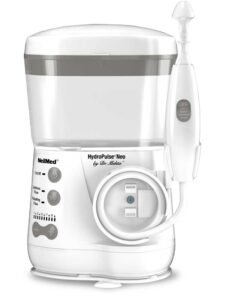Empty Nose Syndrome (ENS) Part Two
In Empty Nose Syndrome, the turbinates have been removed or severely reduced. This causes:
Sensation of not getting enough air
Almost constant discomfort/pain in the nose
Previous allergy is worse
Can’t tolerate cold air or dirty air
Nasal crusting and nose bleeds
Offensive nasal odor
An increase of sinus problems; sinus problems since the surgery
Mechanism: like a garden hose, when the hose opening is wide open, the water has very little pressure and comes out only inches. In the hose, when the opening is made smaller, the water will project several feet.
Because the nose is now wide open, the sensors for air pressure don’t get notified that there is air coming in. That much lowered air pressure “feels wrong” and so the patient feels like he isn’t getting enough air. Unless your doctor understands this, he will be confused.
The sign of ENS is a history of nasal turbinate surgery. There are various procedures that doctors do to open a narrowed airway. Despite care, sometimes too much nasal turbinate tissue is removed or destroyed. Regrettably, there are some doctors that fail to appreciate the need to preserve the nasal cilia function.
A sign of ENS is unusual pain. Because the airflow is severely changed, certain nerve endings may be stimulated. Because the pain is very difficult to pinpoint, the accompanying anxiety is made much worse.
A major sign of ENS is frequent or constant nasal/sinus infection. There may be thick postnasal drainage and a constant sore throat. This is due to the absence of nasal cilia that are no longer there to move bacteria out of the nose, and to help moisten the air to the throat and lungs.
A factor in ENS is a reduced sense of smell and taste. The sense of smell is critical to life’s pleasures. Sometimes the poor smell is the primary complaint of the ENS patient. When smell sense is reduced, that also affects the sense of taste. You enjoy a steak because you can smell the cooked meat. The altered air currents don’t bring the odor particles to the organ of smell in the roof of the nose, plus the excessive dryness are both factors in causing the hyposmia.
For many ENS patients, a CT Scan of the sinuses taken before turbinate surgery may not even show sinus disease, yet for many ENS patients the CT Scan taken a year later does show sinus disease!
Diagnosing ENS
The doctor needs to make a differential diagnosis here. Chronic sinus infection can also cause fatigue, poor sleep, and reduced sense of smell. The difference is that in chronic sinusitis, the airway is seen by the doctor to be swollen and partially obstructed.
Atrophic rhinitis is also called Ozena. Here there is severe nasal crusting, a bad smell from the nose, and the internal nose is wider. This condition runs in families. There is a blockage of the blood supply to the nasal tissue, causing the underlying bones, particularly the turbinates, to shrink. Ozena is present mostly in females. The main difference between Ozena and ENS is that with Ozena, you don’t have a history of nasal surgery. Ozena shows much more foul smelling crusts.
Sjogren’s Syndrome is characterized by dryness of the nose, mouth and eyes. It is an autoimmune disease that involves the glands that moisten the mouth and eyes, as well as the mucus secretions of the nose and throat. In Sjogren’s, the primary complaint is the dry mouth and eye, there is no history of nasal surgery and the nose shows ordinary turbinate tissue.
Therapy:
For ENS the primary problem is lack of nasal cilia and decreased mucus. It is this absence that allows bacteria to grow and penetrate the nasal tissue and cause sinus disease. Therefore the best therapy is pulsatile irrigation because the pulsing saline going through the nose and sinuses, pulsing at a rate analogous to the normal pulse rate of the cilia, performs like regular cilia action. This pulsing action with enhanced saline used early will prevent the significant sinus infections that often accompany ENS. The Hydro Pulse™ Nasal/Sinus irrigator pulses at a rate similar to good cilia function
Pulsatile irrigation for ENS also helps to massage the nasal tissue and bring more circulation to nasal tissue. If biofilm forms in ENS, pulsatile irrigation is an effective means of removing these organized bacterial colonies. Later, if sinus disease has developed as a result of ENS, pulsatile irrigation is effective in clearing the sinus disease by pulsed irrigation. Of particular value is the fact that you can add your prescribed antibiotic to the pulsatile irrigation solution and avoid the systemic antibiotic effects.
In ENS it is especially important to avoid the preservatives such as benzalkonium for saline irrigation/moistening. The product, Breathe.ease XL is specially designed for ENS, containing needed elements for the cilia and being free of preservatives.
Where there are crusts in the nose, Hydro Pulse™ Nasal/Sinus irrigation is of particular value, since pulsed irrigation is much more effective for loosening and removing crusts. Pulsed irrigation is also favored in orthopedics for this purpose.
In ENS, measures to improve immune factors are important. Take iron if your hemoglobin is low, take Probiotic or yogurt to aid the production of immune factors. CQ 10 can be a help. Depending on what the doctor finds, he may ask you to use Premarin vaginal cream in the nose to build up membrane thickness.
Avoid cortisone nasal sprays as these will thin the nasal tissue.
ENS patients suffer needlessly because the diagnosis is not well understood. Except for articles by myself and a few others, there hasn’t even been a course on ENS given until 2013!
Therefore, I hope the reader here will post this information on their web/ and link to it so that others can be informed.
When you join the team to spread the word for less drugs, less surgery, you help all of mankind.

